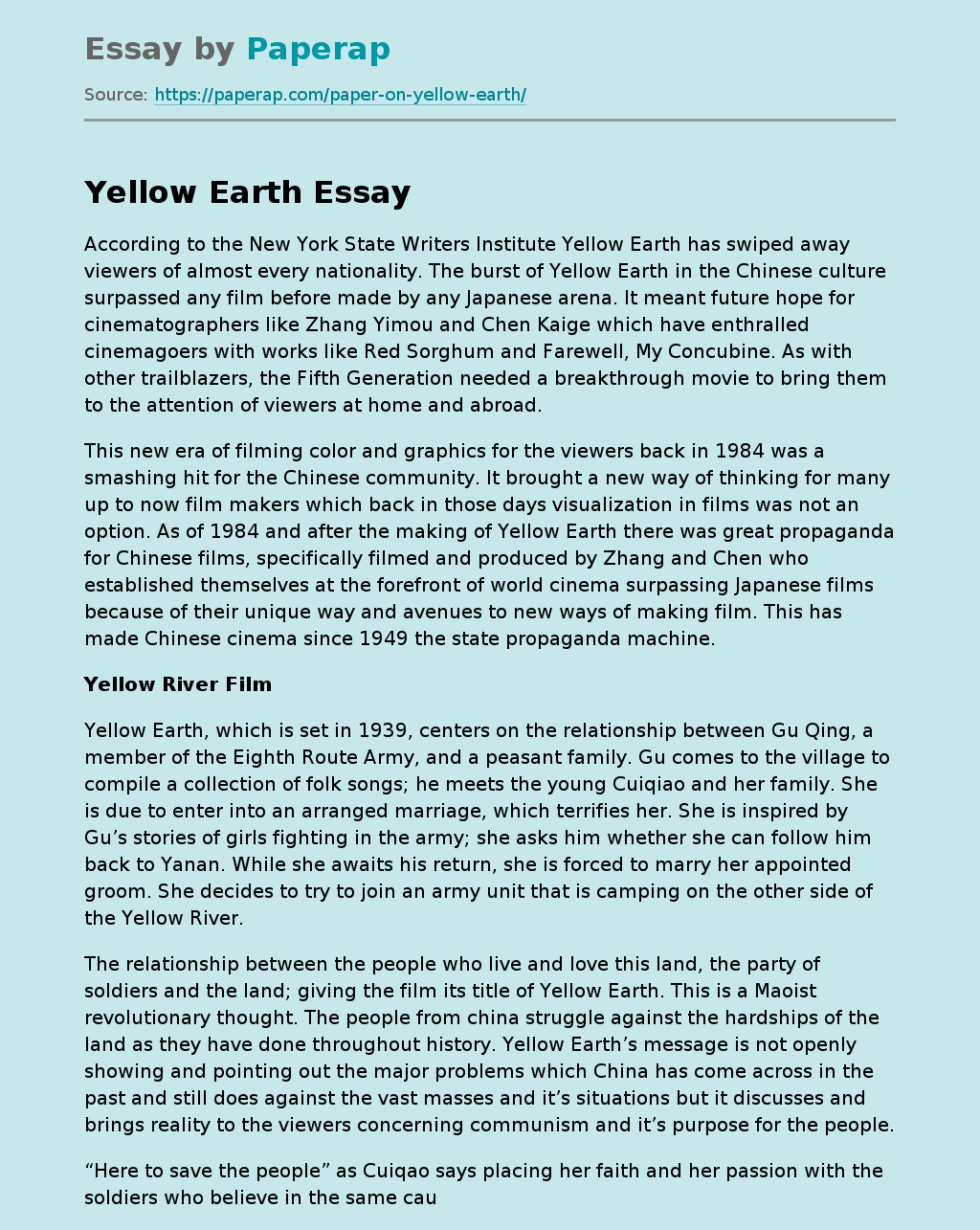Yellow Earth's Global Impact
According to the New York State Writers Institute Yellow Earth has swiped away viewers of almost every nationality. The burst of Yellow Earth in the Chinese culture surpassed any film before made by any Japanese arena. It meant future hope for cinematographers like Zhang Yimou and Chen Kaige which have enthralled cinemagoers with works like Red Sorghum and Farewell, My Concubine. As with other trailblazers, the Fifth Generation needed a breakthrough movie to bring them to the attention of viewers at home and abroad.
This new era of filming color and graphics for the viewers back in 1984 was a smashing hit for the Chinese community. It brought a new way of thinking for many up to now film makers which back in those days visualization in films was not an option. As of 1984 and after the making of Yellow Earth there was great propaganda for Chinese films, specifically filmed and produced by Zhang and Chen who established themselves at the forefront of world cinema surpassing Japanese films because of their unique way and avenues to new ways of making film.
This has made Chinese cinema since 1949 the state propaganda machine.
Yellow River Film
Yellow Earth, which is set in 1939, centers on the relationship between Gu Qing, a member of the Eighth Route Army, and a peasant family. Gu comes to the village to compile a collection of folk songs; he meets the young Cuiqiao and her family. She is due to enter into an arranged marriage, which terrifies her. She is inspired by Gu’s stories of girls fighting in the army; she asks him whether she can follow him back to Yanan.
While she awaits his return, she is forced to marry her appointed groom. She decides to try to join an army unit that is camping on the other side of the Yellow River.
The relationship between the people who live and love this land, the party of soldiers and the land; giving the film its title of Yellow Earth. This is a Maoist revolutionary thought. The people from china struggle against the hardships of the land as they have done throughout history. Yellow Earth’s message is not openly showing and pointing out the major problems which China has come across in the past and still does against the vast masses and it’s situations but it discusses and brings reality to the viewers concerning communism and it’s purpose for the people.
“Here to save the people” as Cuiqao says placing her faith and her passion with the soldiers who believe in the same cause and contributes to her inspiration of making her land a better place to live. This is the first film to emerge from China and one of the most thrilling debut features of the ’80s; catching the attention of the viewers, nationally and internationally. A Communist soldier visits a backward village in 1939, and is billeted with a taciturn widower and his teenage daughter and son. The soldier’s mission is to collect folk songs, and it’s through the exchange of songs that he gradually wins the trust and affection of his hosts.
The widower’s young daughter is to be sold into marriage with a much older man. The soldier’s conversations of breaking up with feudal tradition fills her with unrealistic hopes of escaping her fate as she insistently thinks of a way of leaving her fate to her own battle. The soldier returns to his base, leaving her to take her future in her own hands. There are political undercurrents here that got the film into trouble in China: the encounter between the CP and China’s peasants is shown not as an instant meeting of minds, but as the uneasy, frustrating, and ultimately unresolved process that it actually was.
What really stirred things up in old Beijing was the film’s insistence on going its own way. Chen Kaige and his cinematographer Zhang Yimou have invented a new language of colors, shadows, glances, spaces, and unspoken thoughts and implications; and they’ve made their own language be spoken to anyone involved in the making of this movie as well as viewers from all over the world. Consistent with Chinese art, Zhang Yimou’s cinematography works with a limited range of colors, natural lighting, and a non-perspective use of filmic space that aspires to a Taoist thought :’Silent is the roaring Sound, Formless is the Image Grand’.
The use of silence as a component of Third Cinema is much like the “empty” space of Chinese art or cinema. The long shots of the natural environment possess a respect that is accompanied by silence. By drawing upon characteristics of Chinese art, the fifth generation of China’s film-makers create a new vocabulary, a new filmic language with which to work. By challenging Western aesthetic practice, films such as Yellow Earth can be placed within the realm of a Third Cinema.
Yellow Earth's Global Impact. (2019, Dec 05). Retrieved from https://paperap.com/paper-on-yellow-earth/

